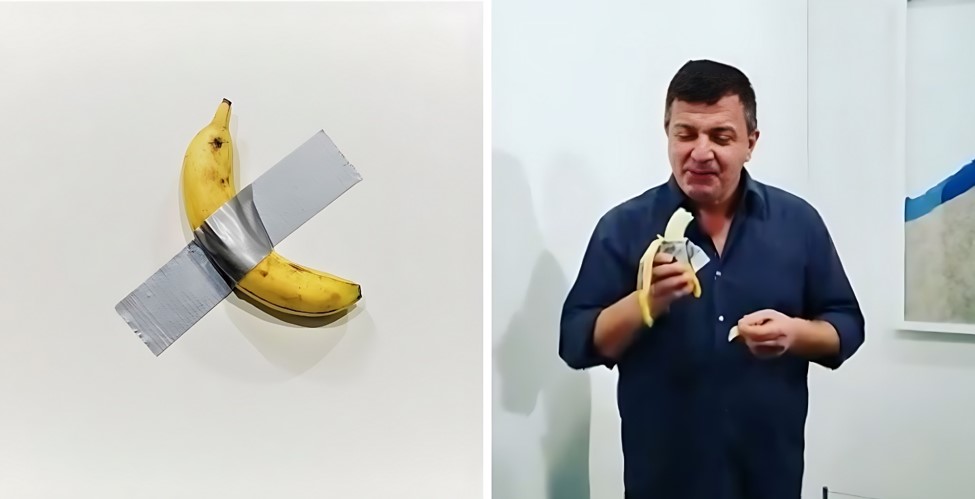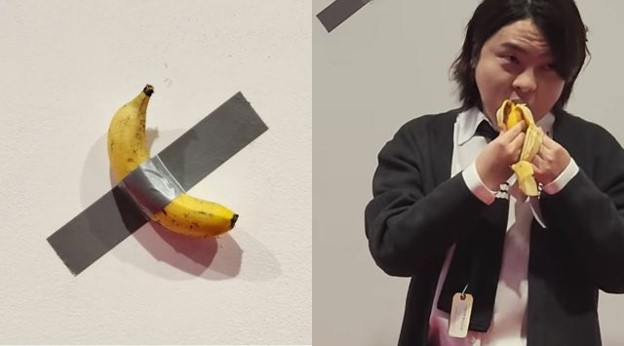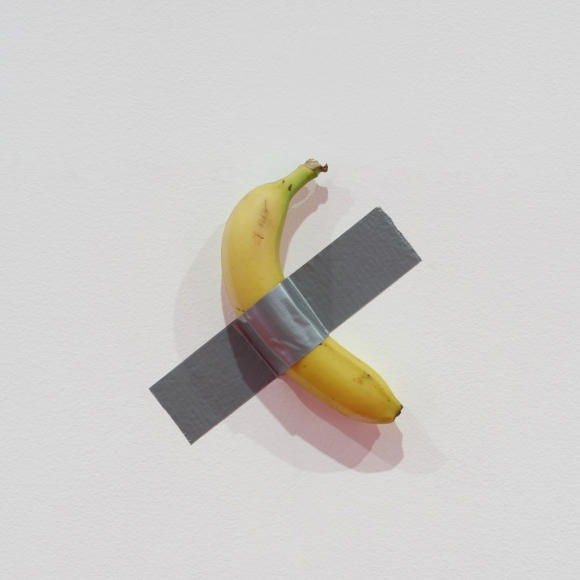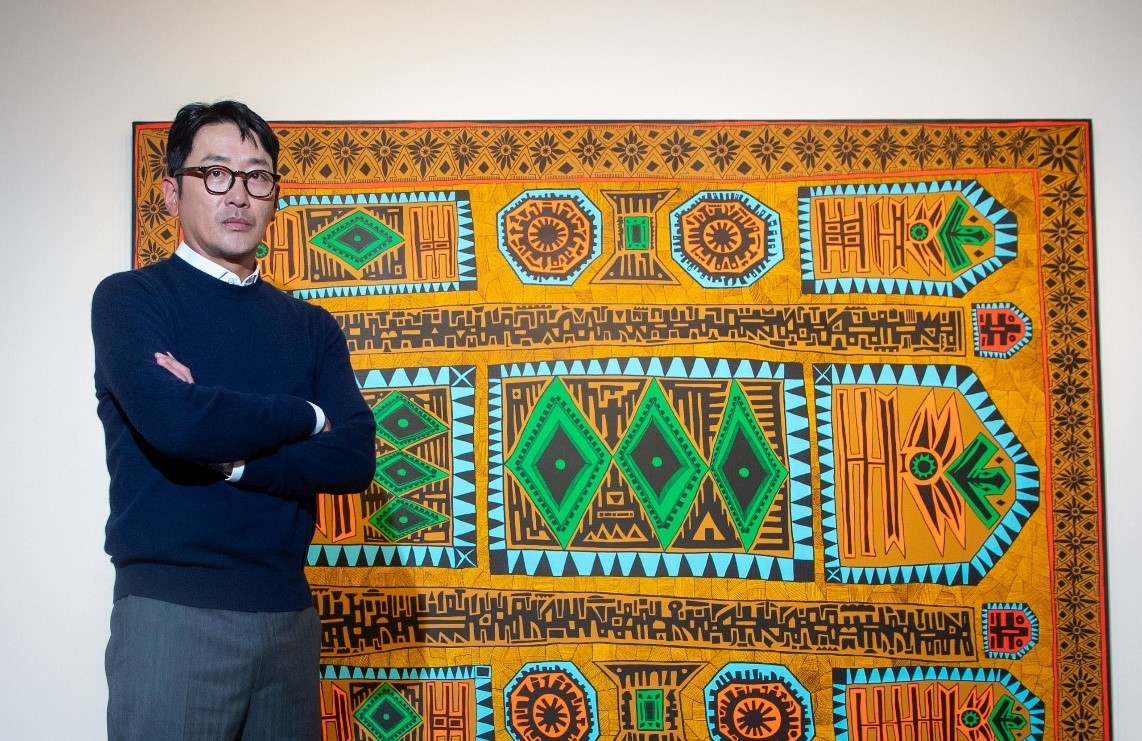On November 20th, Maurizio Cattelan’s
artwork, Comedian, once again stunned the world when it sold
for $6.2 million (approximately KRW 8.67 billion) at Sotheby’s in New York.
This event transcends mere
sensationalism, offering a philosophical lens to reassess how contemporary art
functions within the capitalist system.
 (L) Crypto
entrepreneur Justin Sun acquired the controversial piece for an impressive $6.2
million. / (R) The Sotheby's auction of Comedian, 2024.
(L) Crypto
entrepreneur Justin Sun acquired the controversial piece for an impressive $6.2
million. / (R) The Sotheby's auction of Comedian, 2024.The Controversy: From Miami to Seoul
When Comedian
debuted at Art Basel Miami in 2019, its simplicity sparked instant debate. The
artwork, consisting of a banana duct-taped to a wall, became a lightning rod
for controversy when a performance artist consumed the banana during the
exhibition. The situation was resolved by simply replacing it with another
banana.
 Italian artist Maurizio Cattelan created Comedian, an art
installation consisting of a banana duct-taped to the wall at the Art Basel
Miami festival. The art was highly appreciated and was
sold off for $120,000, and another one for $150,000.
Italian artist Maurizio Cattelan created Comedian, an art
installation consisting of a banana duct-taped to the wall at the Art Basel
Miami festival. The art was highly appreciated and was
sold off for $120,000, and another one for $150,000.Similarly, in early 2023, Cattelan’s Comedian
was displayed at the Leeum Museum of Art in Seoul during his solo exhibition, “WE”.
The piece again made headlines when a fine arts student ate the banana on
display. This act, which some interpreted as a protest, was treated as a
lighthearted incident by both the artist and the museum.

An art student eats the banana at the Exhibition “WE” at Leeum. / @shwan.han/Instagram
The Dual Nature of Art: Spiritual Value vs. Material Commodity
Comedian
lays bare two fundamental attributes of contemporary art. On one hand, it
reflects the imaginative and introspective qualities of art’s spiritual value.
On the other, it embodies the physical and consumable nature of art as a
material object.
While the piece is composed of ephemeral materials—a banana
and duct tape—it gains profound meaning once placed within the context of art.
This notion aligns with Arthur Danto’s
concept of "indiscernibility," wherein art can no longer be
distinguished by visual aesthetics alone. According to Danto, art inevitably
becomes conceptual.
Through this lens, Comedian transcends its mundane
components to claim its identity as art. Yet, as it enters the capitalist
marketplace, it is simultaneously reduced to a commodity. This duality risks
diluting art’s purity and depth, undermining its role as a medium for exploring
the essence of human existence.
The Commodification of Art: Distorted
Essence and Inverted Values
Capitalism, by design, transforms
human desires into material commodities for profit. Comedian
epitomizes how this system infiltrates art in the most extreme way. Its $6.2
million auction price does not merely reflect artistic value but serves as a
symbolic reminder of how art can be exploited as a tool for capitalist
speculation.
The banana in the artwork is no longer
just a banana—it has become a product of capitalist imagery and symbolism. This
transformation vividly illustrates how art struggles between reality and
simulation, exposing the process by which intrinsic artistic value is
overshadowed by commodification.
The commodification of art
fundamentally distorts its essence and creates three critical consequences:
1. Denial of Creativity
The subjugation of art to market logic restricts creative diversity. Artists
are pressured to conform to commercially viable forms and themes, stifling
experimental approaches. This homogenization erodes the intrinsic diversity of
art.
2. Art as a Tool for Capitalist Systems
Comedian serves as an extreme example of how art
becomes an instrument for reinforcing capitalist systems. Paradoxically, the
artwork validates and perpetuates market structures, weakening art’s capacity
to deliver social messages and critique. Instead, it becomes a medium for
amplifying capitalist ideology.
3. Loss of Spiritual Value
While art inherently embodies human spiritual value, the capitalist market
reduces this to speculative consumption and material desires. This not only
diminishes art’s meaning but also distorts and objectifies the essence of human
existence.
Reconsidering the Essence of Art
Art, by its very nature, is not a
commodity. It serves as a vessel for human imagination, philosophical
reflection, and existential values. When art succumbs to capitalism, it
inevitably denies humanity’s spiritual essence. This raises profound questions
about the future of both art and humanity.
Comedian is a stark
reminder of how capitalism consumes and distorts art, but it also carries an
urgent warning: art must reclaim its fundamental value. Cattelan’s infamous
banana challenges us to confront the dilemmas of contemporary art and consider
its future. It will remain a provocative statement, compelling us to rethink
the purpose and direction of art in an era dominated by commodification.
Jay Jongho Kim graduated from the Department of Art Theory at Hongik University and earned his master's degree in Art Planning from the same university. From 1996 to 2006, he worked as a curator at Gallery Seomi, planning director at CAIS Gallery, head of the curatorial research team at Art Center Nabi, director at Gallery Hyundai, and curator at Gana New York. From 2008 to 2017, he served as the executive director of Doosan Gallery Seoul & New York and Doosan Residency New York, introducing Korean contemporary artists to the local scene in New York. After returning to Korea in 2017, he worked as an art consultant, conducting art education, collection consulting, and various art projects. In 2021, he founded A Project Company and is currently running the platforms K-ARTNOW.COM and K-ARTIST.COM, which aim to promote Korean contemporary art on the global stage.












